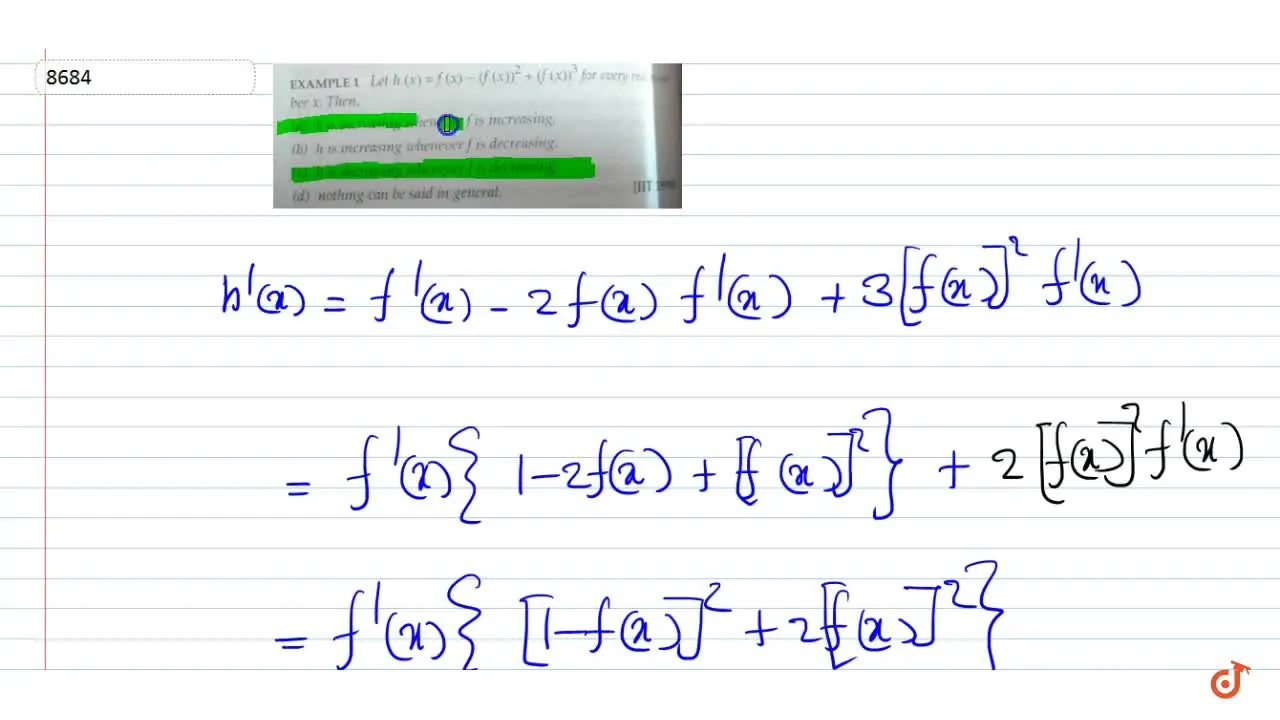Let for every real . Then,
h is increasing whenever f is increasing
h is increasing whenever f is decreasing
h is decreasing whenever f is increasing
nothing can be said in general
The correct Answer is:A
We have
Consider the quadratic expression , Clearly discriminant of this quadratic expression is less than zero . So , its sign is always same as that of i.e.positive .
positive real number
Sign of h'(x) is same as that of f'(x)
h(x) and f(x) increase and decrease together.
Related Playlists
- BOOK - OBJECTIVE RD SHARMACHAPTER - INCREASING AND DECREASING FUNCTIONSEXERCISE - Section II - Assertion Reason Type8videos
INCREASING AND DECREASING FUNCTIONS
- BOOK - OBJECTIVE RD SHARMACHAPTER - INCREASING AND DECREASING FUNCTIONSEXERCISE - Exercise36videos
INCREASING AND DECREASING FUNCTIONS
- BOOK - OBJECTIVE RD SHARMACHAPTER - INCREASING AND DECREASING FUNCTIONSEXERCISE - Chapter Test20videos
INCREASING AND DECREASING FUNCTIONS
- BOOK - OBJECTIVE RD SHARMACHAPTER - HEIGHTS AND DISTANCESEXERCISE - Exercise45videos
HEIGHTS AND DISTANCES
- BOOK - OBJECTIVE RD SHARMACHAPTER - INDEFINITE INTEGRALSEXERCISE - Chapter Test30videos
INDEFINITE INTEGRALS
Similar Questions
Let h(x)=f(x)−(f(x))2+(f(x))3 for every real number x. Then h is increasing whenever f is increasing h is increasing whenever f is decreasing h is decreasing whenever f is decreasing nothing can be said in general
View SolutionLet h(x)=f(x)−(f(x))2+(f(x))3 for every real number x: Then
View SolutionLet h(x)=f(x)−a(f(x))3 for every real number x
h(x) increase as f(x) increses for all real values of x ifView SolutionLet g(x)=f(x)−2{f(x)}2+9{f(x)}3 for all x∈R Then
View SolutionLet h(x)=f(x)−a(f(x))2+a(f(x))3. If h(x) increases as f(x) increases for all real values of x if
View SolutionIf f (0) = 2, f (1) = 3 and f (x+2) =2f (x) - f (x + 1) for every real x then f (5) is equal to
View SolutionLet f(x) be a quadratic expression, which is positive for all real x. Let f(x)=ax2+bx+c,f'(x)=2ax+b,f''(x)=2a, where f'(x) and f"(x) are the first and second derivatives of f(x), respectively. If g(x)=f(x)+f'(x)+f''(x), then for every real x
View SolutionIf f(x)=(x2−10x2+1)), for every real numbers. Then the minimum vlaue of f
View SolutionLet f(x)=sin(x3)+cos(3x10) for all real x. Find the least natural number n such that f(nπ+x)=f(x) for all real x.
View SolutionIf f(x)=x2−1x2+1 , for every real x , then the maximum value of f
View Solution


